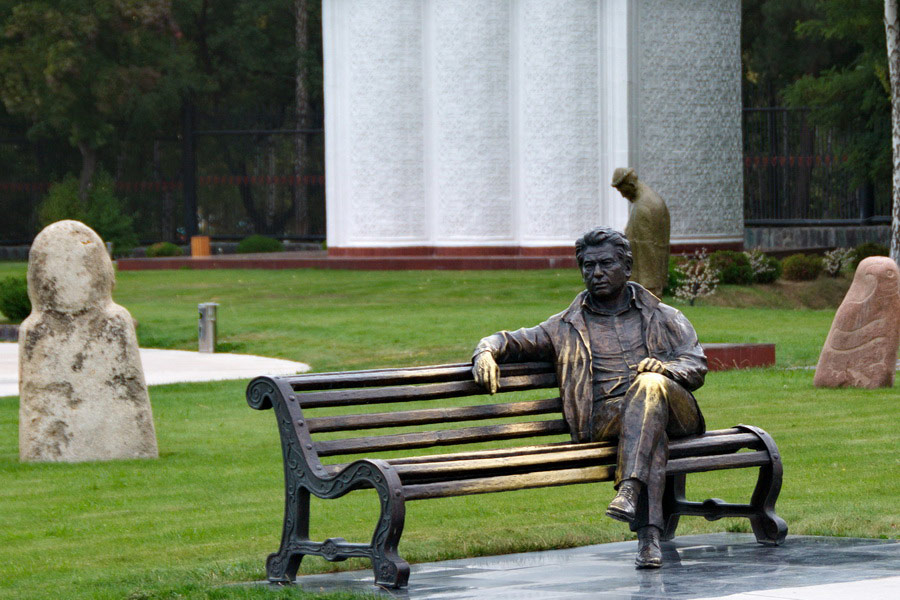
Kyrgyzstan's literature extends across centuries, though it wasn't always written down. Since very little of the population was literate until relatively recently, many poets (known as akyns) traveled from village to village performing their works. Some works, like the Epic of Manas, were memorized and passed down orally between generations of performers, known as manaschi. Literacy increased under the Soviet Union, when schooling became more common, and not just part of a religious education. Starting in the 20th century, writers, poets, and linguists flourished, producing excellent works that became famous around the world.
Chingiz Aitmatov
Chingiz Aitmatov is one of Kyrgyzstan’s most famous writers and politicians, and someone who became famous across the Soviet Union and around the world. His writing describes life in the villages in Kyrgyzstan, and also in the Soviet Union (not always favorably).
Chingiz Aitmatov was born in Sheker, in Talas in 1928, to a family of civil servants. In 1938, his father was arrested and executed for “bourgeois nationalism”. Aitmatov went to study literature at the Gorky Literature Institute in Moscow, and afterwards worked for Pravda, the party newspaper. His first stories were published in the 1950s, when he was still working at Pravda.
His most famous story, “Jamila”, describes a woman falling in love with a quiet outsider while her husband is at the front during World War II. The story centers around life in Kyrgyzstan during the war, when many people were busy growing grain to support the war effort. The story is divisive, spawning discussions about love and duty. Another short story, “Farewell, Gulsary”, features a man reflecting on his relationship with the horse Gulsary as the horse lays dying. The story spans across collectivization and farming in the early Soviet Union as the protagonist runs into problems with the local authorities. Aitmatov’s most famous novel, The Day Lasts More than a Hundred Years, somehow unites futuristic space travel with a remote town on the Kazakh steppe, where a man is trying to give his friend a traditional burial.
His work is famous for its depictions of the folklore and nature of Central Asia, while still remaining contemporary and relevant to modern life. Without ever seeming dated, Aitmatov’s stories reflect and honor the nomadic past of Kyrgyzstan and Kazakhstan, while also addressing (though not always positively) the way that life had changed under Soviet rule.
Alongside being Kyrgyzstan’s most famous author, Aitmatov was also a political figure. He served as an advisor for Gorbachev during perestroika, and as an ambassador from the Soviet Union, and later from Kyrgyzstan, to Luxembourg and other European organizations. He was also politically active in Kyrgyzstan, helping to found Ata-Beyit Cemetery, where he was eventually himself buried. Ata-Beyit was built at the location of a mass grave where 137 or 138 political prisoners, with Chingiz Aitmatov’s father most likely among them, were executed and buried in what was once a brick kiln.
Aitmatov won many prizes for his writing, and has been honored around the world. He wrote in both Kyrgyz and Russian, sometimes working on translations of his own work. His writings have since been translated into many languages, and have become the main literary export of Kyrgyzstan. Aitmatov died in 2008, and was buried at Ata-Beyit. His house, to the south of Bishkek, has become a museum open by appointment to visitors.
Other writers
Kyrgyzstan’s long literary tradition has mostly involved pieces memorized and passed down orally; only beginning in the 19th and 20th centuries were these works written down. Up until then, the most famous pieces of literature were written by improvisatory poets, or akyns, who would often recite their works while accompanying them with music. Under the Soviet Union, Kyrgyz literature was developed, and poets and writers both wrote and translated for the local population.
One issue that hindered the development of a broader literary scene before the 20th century was the lack of a suitable alphabet. Until 1927, Kyrgyz was written with the Arabic alphabet, and it is still written this way among the ethnic Kyrgyz in China. Kasym Tynystanov was a poet and academic who developed the first alphabet specifically for Kyrgyz, using a modified Latin alphabet, that better fit the peculiarities of the language, and was better suited for printing. Tynystanov also collected and recorded Kyrgyz folklore and contributed to other scientific endeavors until his arrest and execution in 1938. Yasyr Shivaza was another poet and linguist active in the early Soviet Union, when he helped develop an alphabet for the Dungan language and translated famous works into Dungan.
Aaly Tokombaev and Alykul Osmonov were two other poets and writers who were famous in the Soviet Union. Osmonov helped to translate famous works (including Shakespeare and Pushkin) into Kyrgyz, as well as writing poetry that helped Kyrgyz poetry transition from being oral to written. Tokombaev wrote poems about what he saw as the unfair treatment of Kyrgyzstan under Soviet Rule. Today, Osmonov is featured on the 200 som bill, and Tokombaev has a street named after him in Bishkek.

